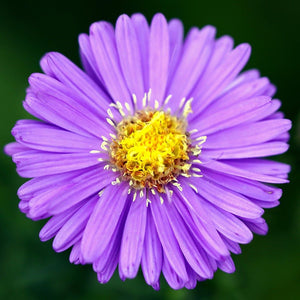Aster: Reliable Fall Color and Heavy Pollinator Traffic
Welcome to this week’s “Plant of the Week.” If you want dependable late-season color that feeds pollinators when resources run low, Aster (modernly classified as Symphyotrichum for many species) is a smart, low-maintenance choice for northern landscapes. From compact mounds to upright border anchors, asters deliver weeks of daisy-like bloom in purple, blue, pink, and white - right when borders need a second wind.
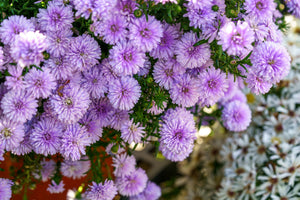
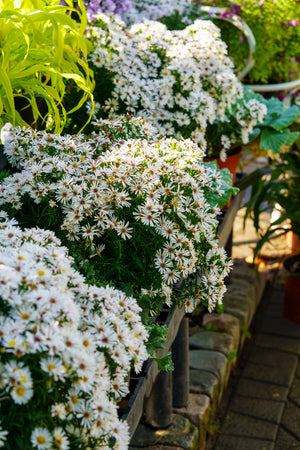
What Makes Aster Special?
Asters are long-blooming, fall performers, typically flowering from late August through October in New Jersey. Masses of small, starry flowers blanket the plants, creating strong color blocks that read from a distance while still offering fine texture up close. They are pollinator powerhouses, supporting native bees, migrating butterflies, and beneficial insects late in the season.
Modern garden asters span useful forms: threadleaf and aromatic asters (e.g., S. oblongifolium) make tidy mounds with excellent drought tolerance and clean, mildew-resistant foliage; New England aster (S. novae-angliae) brings taller vertical presence and saturated purples and pinks; smooth aster (S. laeve) offers glaucous foliage with strong stems for upright, wind-resistant displays. Many compact selections stay under 18–24 inches; larger types can reach 3 to 4 feet, providing structure in mixed borders.
Asters thrive in full sun and well-drained soils, are generally deer-resistant, and are hardy across USDA Zones 3 to 8 (some to 9). Once established, most tolerate brief dry spells, especially the aromatic and threadleaf types.
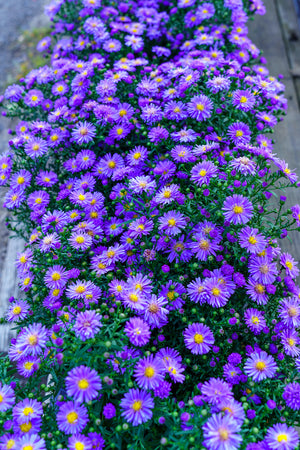
How to Use Aster in the Garden
Pollinator and Meadow Plantings
Plant in drifts to create a nectar corridor for late-season foragers. Pair with goldenrod (Solidago) to echo classic fall yellow-and-purple colorways, and intersperse with native grasses like little bluestem or switchgrass ‘Shenandoah’ for movement and winter seed structure.
Sunny Borders and Mixed Perennial Beds
Use compact asters along the front or mid-border to stitch spaces between summer perennials that are fading. Taller New England or smooth asters anchor the back with color that carries through fall. Combine with Sedum, rudbeckia, salvia, and Russian sage for long, overlapping bloom.
Containers and Small Spaces
Dwarf, mound-forming selections suit patio pots and narrow beds where reliable fall color is needed with minimal upkeep. A single containerized aster can serve as a small focal point near entries when the rest of the garden is winding down.
Cutting and Display
Sturdy stems and abundant blooms make asters useful for cut arrangements. Harvest when outer florets are open; recut stems and change water regularly to extend vase life.
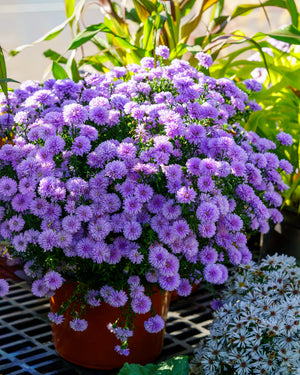
How to Care for Aster
Site & Soil: Full sun (6+ hours) yields the best flower density and strongest stems. Average, well-drained loam or sandy loam is ideal; avoid soggy sites, especially in winter.
Watering: Keep evenly moist during the first growing season. Thereafter, water deeply but infrequently. Threadleaf and aromatic types are notably drought-tolerant once established.
Fertilizing: Go light. Over-fertilizing can cause flop. A thin spring top-dress of compost is usually sufficient.
Pinching/Shearing: For taller types, pinch once in late May to early June to encourage branching, reduce height, and delay bloom slightly for a denser late show. If plants get tired after the first flush, shear lightly to promote a tidy second wave.
Staking: Generally unnecessary for compact cultivars. Stake only the tallest selections in windy sites.
Deadheading: Optional. Removing spent flowers tidies the plant and can extend bloom on certain selections.
Spacing: Most compact forms do well at 18–24 inches on center; larger border types at 24–30 inches to ensure airflow and reduce mildew.
Disease & Pests: Choose mildew-tolerant selections and maintain sun, spacing, and airflow. Water at soil level rather than overhead. Asters are typically pest-light; occasional leaf spots are mitigated with sanitation and spacing.
Division & Renewal: Divide every 2–3 years in spring to maintain vigor, prevent center die-out, and propagate more plants.
CONCLUSION
Asters offer a reliable solution for filling the fall color gap while supporting pollinators. With forms ranging from compact mounds to upright border mainstays, they fit containers, meadows, and mixed beds with equal ease. Plant in sun, keep the soil draining, and use a quick pinch in early summer for dense, upright plants that deliver weeks of late-season bloom.
Visit Plant Detectives to explore the aster forms and colors that will work best in your beds, borders, meadows, and fall displays.

